OBP defined:- Optimum Body Positioning. A synonym for "Good Posture". "Good Posture"
has so many bad vibes about it (memories of parents saying "sit up straight",
"don't slouch", "chest out", "shoulders back", "tummy in"), that the concept has
to be revived under a different name. Hence the term "OBP".
Tennis Elbow defined:-
The key injury is small tears of the tendon at the upper end of
the extensor carpi radialis brevis muscle (ECRB for short). The tendon tears are
caused by jarring when the muscle is used in an over tense way. Likewise, healing
can be slow due to the muscle remaining tense even when you are resting.
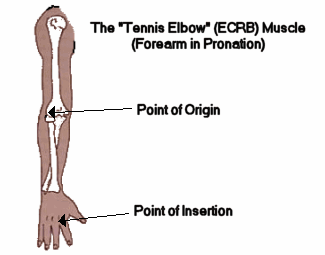 |
Diagram 1:
shows where the ECRB ("tennis elbow" muscle) starts and finishes.
|
Pole Planting to avoid Tennis Elbow:-
(1) Use the part in its "OBP" (previously defined). If you are a cross country skier,
check out the diagrams below. Line Trace number (2) in the table below shows the
forearm with the wrist at its "OBP". This is close to the ideal.
| Table of Pictures: Demonstrating excessive muscle tension in the skier's
forearm when it is not operating at its "OBP". |
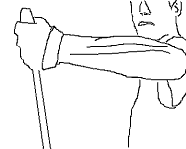 |
Line Trace Number (1):-
Skiers arm with elbow pointing horizontally outward.
Note the strong definition of the muscles. These muscles are under tension.
|
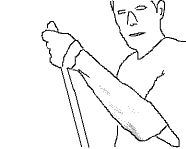 |
Line Trace Number (2):-
Skier's arm with elbow pointing about 15 degrees lateral of vertically down.
This puts the wrist at or close to its "OBP". Note the weak definition of the muscles.
These muscles are not under tension, which is the ideal.
|
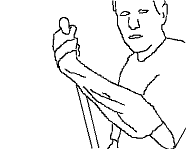 |
Line Trace Number (3):-
Skier's arm with elbow pointing downward, but this time with the wrist flexed.
Note the strong definition of the forearm muscles. These muscles are under tension.
|
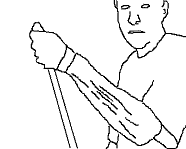 |
Line Trace Number (4):-
Skier's arm with the elbow pointing downward, and this time with the wrist over-extended.
Again, note the strong definition of the forearm muscles. These muscles are under tension.
|
(2) Place your poles "deliberately". You can do this if you reach forward.
Reaching forward gives your arms sufficient time to start pushing down gently, and without "jarring"
as the pole hits the snow. (Note: "reaching forward" is something you do with your
whole body from the ankle joint upward. But that will be the subject of another article...).
Management of Tennis Elbow when not Skiing:-
Both at work and while resting, keep the joint of interest (in this case the wrist and forearm)
in or close to its middle range.
This is really important, and should probably be the key point taught by your physiotherapist.
The middle range of a joint is where the muscles around it:-
- are at their strongest,
- are at their best mechanical advantage,
- are able to co-ordinate well with each other,
- are best able to relax while resting,
- are as relaxed as they can be for the job at hand. Ask yourself what transmits
a shock wave best, a string stretched tight, or a string hanging loose?
It's the same with the muscles or your arm!
Do you begin to see the usefulness of the concept of "OBP" (Optimal Body Positioning)?
If you are not suffering from tennis elbow while skiing, the above advice is probably
all you need. If however you are in pain, you should check out the following articles:-
(Note: please go gently with any weight training and stretching advice!
Remember the concepts of "OBP" and the strong middle range, and you will get the
quickest response out of standard physiotherapy!)
© Bruce Thomson, EasyVigour Project
Return to Top
|



